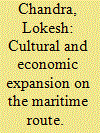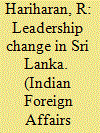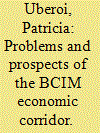| Srl | Item |
| 1 |
ID:
138665


|
|
|
| 2 |
ID:
139048


|
|
|
|
|
| Summary/Abstract |
At the strategic security level, apart from Sri Lanka’s bid to renew relations with India, China’s concerns with the Sirisena government relate to its ambitious power projection in South Asia and the Indian Ocean Region (IOR). Sri Lanka has emerged as a key strategic pivot astride the Indian Ocean to further China’s 21st Century Maritime Silk Route (MSR). Sri Lanka has already announced its support to the initiative. China has recently announced an outlay of US$ 40 billion for the MSR. With this huge investment, and those already made in port and road infrastructure projects in Sri Lanka and Pakistan, China simply cannot afford any obstruction to the completion of MSR, which would increase its strategic reach in keeping with its global ambitions. China has tried to use its existing discounted but firm relationship with Sri Lanka by turning President Sirisena’s desire to rebalance Sri Lanka’s relations with India as an opportunity for evolving a triangular relationship with India and Sri Lanka. This would help China further its strategic objectives in IOR and South Asia, as well as bring in India to join the MSR and turn it into a successful project.
|
|
|
|
|
|
|
|
|
|
|
|
|
|
|
|
| 3 |
ID:
148058


|
|
|
|
|
| Summary/Abstract |
The Bay of Bengal is of vital strategic, economic and maritime importance, as the Andaman Sea and the Malacca Straits link South and Southeast Asia. The Bay is intrinsically rich in hydrocarbons and minerals. Several major rivers of Asia flow into the Bay and the adjoining seas creating vast sedimentary basins that have potential hydrocarbon deposits. The growing role of the Bay of Bengal as a reservoir of vital resources has contributed to the regional powers’ ability to exert influence in this arena. The changing dynamics are particularly relevant for India and China, whose rising economies are dependent on the steady flow of resources, most importantly oil. The geopolitics of the increasingly volatile South China Sea could possibly impact on India’s interests and relations with Southeast Asian countries. This paper examines whether China and India’s Indian Ocean strategies underpin greater cooperation, rather than competition to generate synergies in the region.
|
|
|
|
|
|
|
|
|
|
|
|
|
|
|
|
| 4 |
ID:
143291


|
|
|
|
|
| Summary/Abstract |
This article takes a critical look at the new Chinese ‘One Belt, One Road’ (OBOR) or ‘Belt and Road Initiative’ (BRI) for 21st century Eurasian connectivity and economic integration from the perspective of the proposed Bangladesh–China–India–Myanmar Economic Corridor (BCIM-EC). The BCIM-EC is a sub-regional cooperation project that aims to link the land-locked provinces of southwest China with eastern India and the Bay of Bengal through northern Myanmar, India’s northeast region, and Bangladesh. However, within months of being mooted in May 2013, the BCIM-EC was yoked to another connectivity initiative, the China–Pakistan Economic Corridor (CPEC), and the two encompassed within President Xi Jinping’s grand vision for a new overland and maritime Silk Road. As of now, India has (i) endorsed the BCIM-EC, (ii) rejected the CPEC and (iii) maintained studied silence on the OBOR initiative per se. Where does that conundrum leave the BCIM-EC? And to what extent, if at all, can India leverage OBOR to its own advantage?
|
|
|
|
|
|
|
|
|
|
|
|
|
|
|
|
| 5 |
ID:
151132


|
|
|
|
|
| Summary/Abstract |
This paper would focus on twenty-first century maritime silk route poser in between China and India. Beijing as a rising economic super power in the world is pronounced as a complicated feature of the Twenty-first century. The economic rise of China put pressure on Beijing’s leadership to secure its economic growth and hegemonic power position in the region. Therefore, Beijing strategically gear up its military modernisation and weapon procurement policy. The main focus is on naval development and regional connectivity through the newly initiated Silk Road and twentyfirst century maritime silk route projects, which makes big powers like US, Japan, and India suspicious about the intention of China.
|
|
|
|
|
|
|
|
|
|
|
|
|
|
|
|